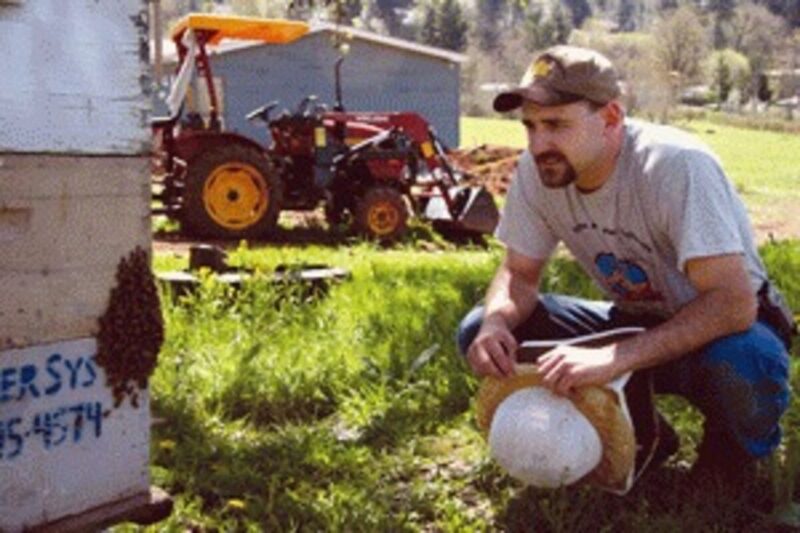Scott Swanson
Of The New Era
Life’s gotten tough for honeybees.
Bee populations, both domestic and wild, have dropped dramatically in the last few years in parts of the nation, and some local beekeepers say they’ve experienced severe losses in their hives.
“We were hit very hard,” said Jenny LaFond, who with her husband Alan operate Cascade Honey and Pollination in the Lacomb area. The LaFonds, who operate between 1,800 and 1,900 hives, one of the largest operations in the area, lost about two-thirds of their bees over the winter, she said.
Richard Farrier of Jefferson, president of the Willamette Valley Beekeepers Association, said life has gotten a lot more complicated for beekeepers, who are having to deal with a whole litany of threats unheard of in the not-too-distant past.
“Beekeeping used to be easy. Nowadays it’s terrible,” Farrier said, listing various maladies that are killing bees: the traditional foul brood, various mites, viruses, small hive beetles and pesticides. “It’s a whole new ballgame. You have to be watching your hives pretty close.”
Mites are blamed for many local losses, and some pesticides are probably causing bee greater numbers of bee fatalities, he said.
Farrier said all hives lose some bees during “overwintering,” the period when bees are dormant during cold weather. But “if everything was right,” those losses would be about 20 percent.
“Anything above that is unusual,” he said. “My losses were about 60 percent.”
Franz Yordy, operator of Snow Peak Apiaries in the Lacomb area, which manufactures beekeeping equipment, runs about 800 hives. He said the problems affecting bees’ health “have been building for years.
“This is the worst year ever,” he said.
Domesticated honeybee populations have declined by about 50 percent over the past 50 years, scientists say. The drops have been particularly severe in the past few years along the East Coast, most severely in the last year, when farmers in the east and in California were unable to get sufficient pollination for their fruit and nut orchards and failed to meet expected yields as a result.
Causes of the problem, which has been termed Colony Collapse Disorder, are not clear, but preliminary research by university and federal researchers, state regulatory officials and others has pointed to several likely factors, including mites and associated diseases, some unknown pathogenic disease and pesticide contamination or poisoning.
The mites are not a new problem, local beekeepers said. The varroa mite and tracheal mite have “all but decimated the casual beekeeper and feral (wild) bees in North America,” according to an on-line report by Ohio State University.
“Locally, I think it’s mites and viruses,”said Farrier, who usually has about 200 hives in operation, though his numbers are down right now. “A lot of people have been using chemicals (to control mites) but the mites have become resistant to chemicals. We don’t know a lot about viruses. They’re kind of like human viruses. They exist but we don’t know a lot about them.”
Farrier said that new chemicals have recently been introduced that may help control the mites and some beekeepers are trying to medicate their colonies earlier in the year, which means they get a smaller harvest but may be able to preserve more of their bees.
“A lot of guys like to get that late honey but may have to give that up to keep their hives alive,” he said.
Fungus has been a problem in the east, killing off bee populations, but local beekeepers said they haven’t had problems with it in the Willamette Valley.
Pesticides, though, are raising concerns.
Yordy said that a lot of the factors behind the bee population decline is speculation, but the threat of insecticides is making him cautious about where he places his bees during the pollination season this year.
He said neonicotinoid or imidacloprid pesticides, which use a synthetic form of nicotine, are used to coat seeds to build plants’ resistance to pests, but the substances can get into pollen, which affects bees. Neonicotinoids are believed to cause bees to “come down with all sorts of viruses” and affects their brains – “they leave the hive and don’t come back,” Yordy said.
The insecticide Gaucho, which is one of many that contain neonicotinoids, has been blamed for increases in bee mortality and has been banned in France for use on certain plants.
“At this point I’m not sure what crops I want to do out in the valley,” Yordy said. “I want to talk to farmers. I don’t want to be around anything that has Gaucho in it.”
Yordy sends hives to California for the almond pollination season, then brings them back to pollinate crops locally.
He said he has sustained losses, but was reluctant to go into detail.
One local beekeeper, Jim Strawn of Sweet Home, said he has not experienced the decline in his small hobby operation in the Foster area. Strawn bought several hives last year and said they overwintered well. But he said he knows others who have had serious problems.
Farrier said the recent threats have made life a lot more complicated for beekeepers.
“You have to be watching your hives pretty close,” he said. “You almost have to be a scientist to take care of bees these days. It’s expensive to keep them alive.”
If bee populations continue to decline, grocery shelves could see heavy adverse effects. Bees are responsible for 15 to 30 percent of the foods Americans eat. Scientists warn that unless action is taken to slow the decline, many fruits and vegetables may disappear from the food supply.
“Einstein said when the bees are gone, mankind only has four years left,” Yordy said.





